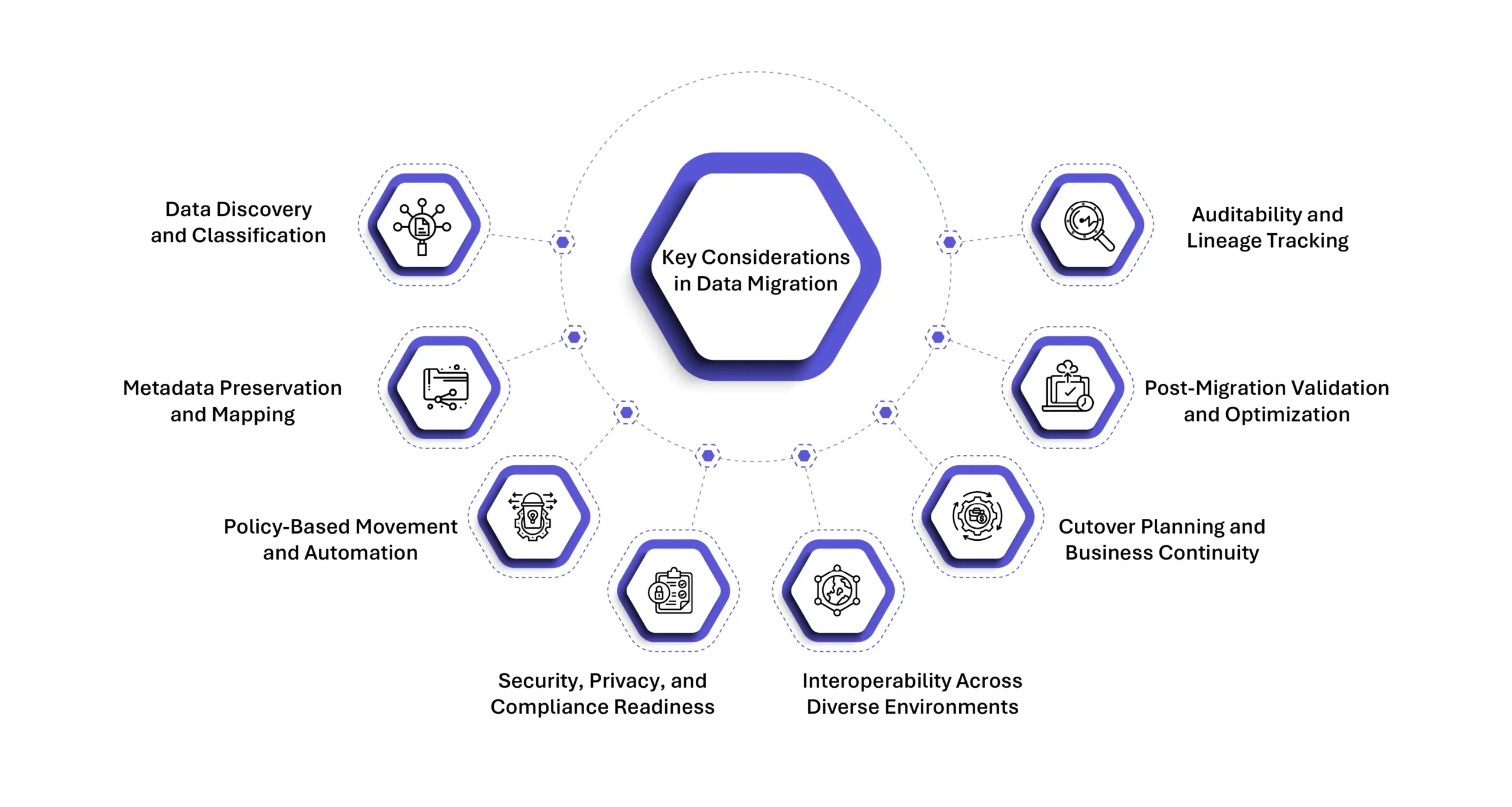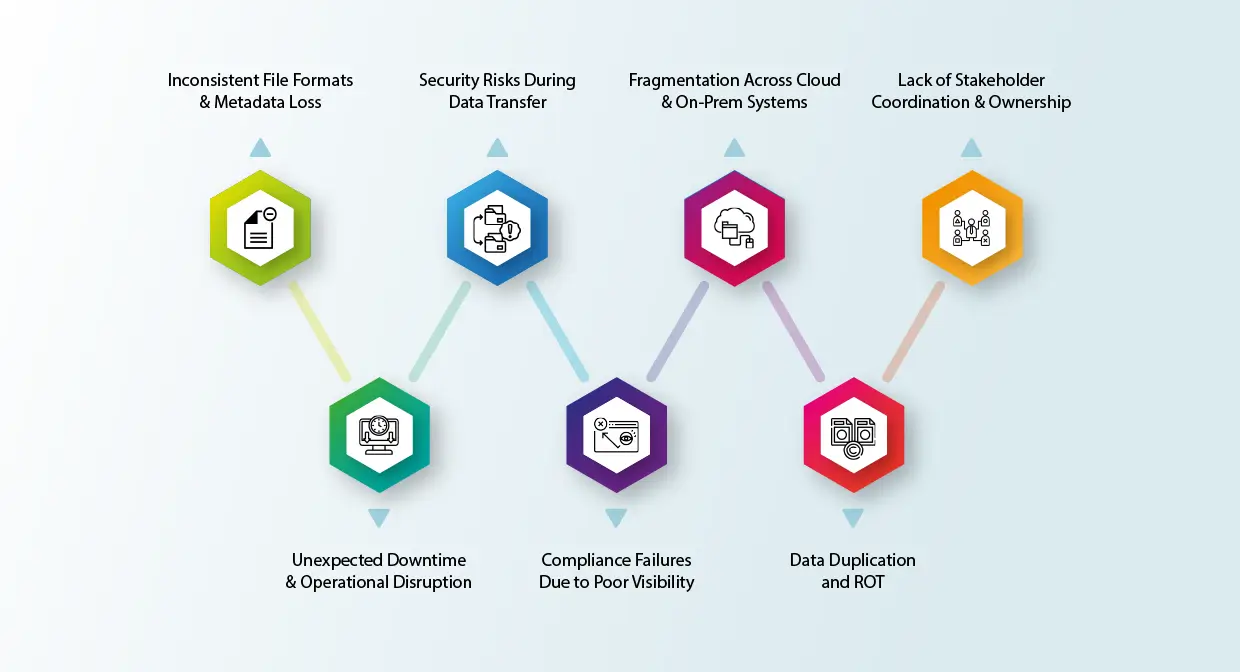What is Data Migration?
Data Migration is a process of transferring data from one system or storage to another, essential for organizations seeking to modernize their IT infrastructure, optimize operations, or adopt new technologies like cloud computing. This process involves carefully analyzing, mapping, and transforming data to ensure it aligns with the requirements of the target system, while minimizing disruption to business operations. Effective data migration requires meticulous planning, execution, and validation to guarantee that data integrity, accuracy, and accessibility are maintained throughout the transition, ultimately enabling the organization to leverage new capabilities and drive growth.
Done right, it helps organizations maintain operational continuity while improving performance, compliance, and cost efficiency. Done poorly, it can lead to downtime, data loss, or serious regulatory violations.
Why is Data Migration Important?
In today’s hybrid, multi-cloud world, where agility and scalability define competitive advantage, legacy systems can quickly become a bottleneck. Businesses are under growing pressure to adapt, starting with their data. According to Gartner, over 50% of data migration projects exceed budget and timeline expectations, underscoring how mission-critical and error-prone this process can be.
Data migration isn’t just about lifting and shifting files. It’s about validating, transforming, classifying, and securing data so it serves your future state just as well—or better—than your past. This is especially crucial when working with unstructured data, which forms over 80% of enterprise information and is often poorly documented.
Types of Data Migration
There are several types of data migration, each tailored to different objectives and scenarios:
- Storage Migration: Moving data from one physical storage system to another (e.g., from on-premise to cloud storage infrastructure).
- Cloud Migration: Transitioning data, applications, and workloads to a cloud computing environment.
- Application Migration: Moving data between software applications or upgrading legacy systems.
- Database Migration: Transferring data between database systems, often involving changes in schema and data formats.
- Hybrid or Multi-Cloud Migration: Orchestrating data movement across complex, distributed environments while maintaining availability and performance.
Key Considerations in Data Migration

A successful data migration strategy must extend beyond the mechanics of data transfer. It requires a proactive, policy-driven approach that ensures data integrity, security, compliance, and long-term usability across the target environment. Below are the essential pillars every enterprise should address before, during, and after migration:
- Data Discovery and Classification: Before migrating, it’s critical to know what data you’re moving. Enterprises often grapple with vast volumes of unstructured data—files, emails, PDFs, media, and logs—that lack proper labeling or business context. Using automated discovery tools, organizations can scan existing repositories to classify data based on content type, sensitivity, age, ownership, and business value. This ensures only relevant, non-redundant data is migrated, reducing volume and cost while enhancing performance.
- Metadata Preservation and Mapping: Metadata is the DNA of enterprise data—it includes access permissions, timestamps, ownership details, and usage patterns. During migration, preserving metadata is crucial for maintaining business continuity, audit trails, and regulatory compliance. Advanced migration platforms ensure that metadata is not only retained but also mapped appropriately to the target systems, especially when formats differ between on-prem, cloud, and hybrid storage environments.
- Policy-Based Movement and Automation: Data migration should be guided by predefined business rules and policies, not manual intervention. This includes retention schedules, legal holds, security levels, and data residency mandates. Automated workflows based on these policies help streamline complex migrations, minimize errors, and enforce consistent governance. For example, a policy might dictate that only files not accessed in 5 years and not subject to legal hold are eligible for cold storage migration.
- Security, Privacy, and Compliance Readiness: Data in motion is inherently at risk. Organizations must implement encryption (in-transit and at-rest), robust access controls, and real-time anomaly detection to mitigate threats during migration. Moreover, compliance with frameworks such as GDPR, HIPAA, CCPA, or India’s DPDP Act must be upheld. This includes ensuring sensitive data like PII or PHI is either excluded, anonymized, or routed to compliant geographies—especially critical in cross-border data transfers.
- Interoperability Across Diverse Environments: Today’s IT environments are heterogeneous, involving NAS devices, object stores, cloud services, and legacy archives. Migration tools must support interoperability across these varied platforms, facilitating file-to-object, object-to-object, and hybrid data movements. The ability to integrate with APIs, legacy systems, and cloud-native protocols is essential for smooth transitions without data corruption or format loss.
- Cutover Planning and Business Continuity: Unplanned downtime during migration can disrupt operations and damage customer trust. A robust migration plan includes staging, piloting, and phased cutover to reduce impact. Real-time replication and delta synchronization allow organizations to keep both environments updated until the final switch, ensuring seamless switchover and data consistency.
- Post-Migration Validation and Optimization: Migration doesn’t end once data reaches its destination. Post-migration validation includes integrity checks, checksum verification, and access permission audits to ensure nothing is lost or altered. Additionally, optimization tasks—such as deduplication, tiering, and data lifecycle management—can be initiated immediately after migration to improve performance and reduce storage costs.
- Auditability and Lineage Tracking: In regulated industries, organizations must demonstrate accountability for every data move. Built-in audit trails and lineage tracking provide visibility into what data moved, when, where, by whom, and under what policies. This traceability is vital for regulatory reporting, forensic investigations, and ensuring long-term governance continuity.
Modern tools go beyond one-time transfers to offer automated, policy-driven orchestration of data migration at scale.
Challenges in Data Migration

Despite its strategic significance, data migration is often riddled with operational and technical hurdles that can derail timelines, inflate budgets, and introduce risk.
- Inconsistent File Formats and Metadata Loss: Migrating data across diverse systems often leads to format mismatches or missing metadata, which can break application dependencies and compromise audit trails.
- Unexpected Downtime and Operational Disruption: Without a phased cutover or real-time sync strategy, migration can interrupt critical services, delay business operations, and negatively impact user experience.
- Security Risks During Data Transfer: Data in transit is vulnerable to interception, corruption, or unauthorized access, especially if encryption and access controls are not properly configured.
- Compliance Failures Due to Poor Visibility: Lack of real-time tracking and classification may result in sensitive data being moved in violation of regional privacy laws or industry regulations.
- Fragmentation Across Cloud and On-Prem Systems: Moving data across hybrid environments can lead to siloed storage, broken workflows, and inefficiencies in data retrieval and management.
- Data Duplication and ROT (Redundant, Obsolete, Trivial Content): Migrating without proper cleansing can carry forward ROT data, inflating storage costs and cluttering the target environment with low-value content.
- Lack of Stakeholder Coordination and Ownership: Cross-functional misalignment between IT, compliance, and business units can delay decision-making, result in policy conflicts, and reduce accountability.
The Strategic Role of Data Migration in Cloud and Business Modernization
As enterprises modernize, the need to move, merge, and modernize data becomes non-negotiable. Cloud storage infrastructure, in particular, offers scalability and flexibility, but it also demands structured, clean data to deliver full value. Organizations are investing in shared storage systems and centralized data repositories to support analytics, AI/ML workloads, and long-term sustainability goals.
Whether you’re consolidating servers, onboarding a new AI platform, or implementing a Zero Trust architecture, data migration is a foundational enabler.
At Data Dynamics, we see data migration not as a one-time event, but as a strategic lever for transformation. Our intelligent data mobility capabilities enable secure, policy-based, and automated movement of unstructured data across hybrid and multi-cloud ecosystems. From file-to-object to object-to-object migration, our solutions help enterprises modernize without risk.
With metadata analytics, classification engines, and robust automation, our platform ensures that only the right data is migrated, at the right time, to the right location, supporting performance, compliance, and cost optimization.
Data migration is more than a technical necessity—it’s a business opportunity. It allows organizations to align their storage infrastructure with evolving needs, reduce costs, eliminate ROT, and build a foundation for innovation.
Getting Started with Data Dynamics:
- Learn about Unstructured Data Management
- Schedule a demo with our team
- Read the latest blog: Data-Driven by Design: The CIO-CDO Playbook for AI Transformation in the Middle East






